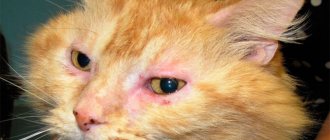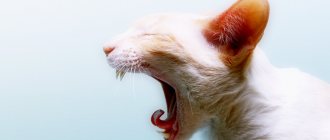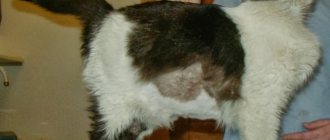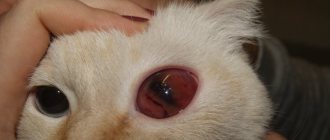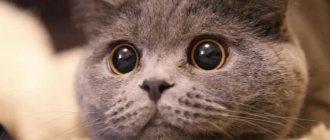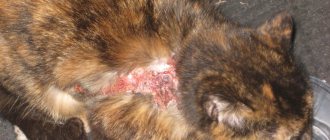Nephrosclerosis is a disease caused by the replacement of renal parenchyma with connective tissue, which contributes to compaction and shrinkage of the organ. As a result of this pathological process, kidney function is impaired. In medicine there is another name for this pathology - wrinkled kidney.
Kidney nephrosclerosis is of two types, depending on the mechanism of development:
- primary, arising due to impaired blood supply to organ tissue, due to hypertension, atherosclerosis and other vascular diseases;
- secondary, which accompanies some kidney diseases, for example, nephritis, congenital anomalies.
This pathological condition occurs not only in humans, but also in animals. For example, nephrosclerosis in cats can occur without obvious clinical signs: the temperature is normal, but weakness, lethargy, increased thirst, and weight loss are observed. To identify the disease as early as possible, you need to conduct a urine test and ultrasound.
Types of disease
There is a classification of pathology, which is based on both the cause of its development and its main manifestations.
1. Hypertensive nephrosclerosis
(arteriolosclerotic), which has a primary development mechanism, occurs due to regular increased pressure in the vessels and narrowing of their lumen. As a result of insufficient blood circulation in the organ, cellular hypoxia increases and the atrophied kidney parenchyma is replaced by connective tissue.
The hypertensive type of disease can occur in two forms depending on the symptoms - benign and malignant.
Benign arteriolosclerotic nephrosclerosis is often combined with atherosclerosis of the renal artery. Although this form can be compensated, over time, degeneration of most nephrons leads to renal failure. The malignant form is characterized by fibrinoid necrosis of arterioles and glomerular capillaries, hemorrhages, as well as protein atrophy of the epithelial tissue of the tubules. This form leads to kidney failure more quickly than the benign form and is more often fatal if hemodialysis is not performed on time.
2. Atherosclerotic nephrosclerosis
caused by stricture of the renal artery by atherosclerotic plaque. Usually the pathology is unilateral. Connective tissue replaces the wedge-shaped atrophied areas, as a result of which the organ becomes large-lumpy, but this does not greatly affect its functionality due to the small volume of the lesion. With this stenosis, hypertension of the renal vessels usually develops.
3. Diabetic nephrosclerosis
(DN) is characterized by microangiopathies that completely affect the organ. At stage 1, this complication is difficult to diagnose due to the lack of obvious symptoms. If diagnosed late, the disease leads to irreversible results.
Diabetic nephrosclerosis has several stages:
- the first stage is diagnosed only using a method for determining the rate of glomerular filtration of various substances (for example, creatinine or insulin) or a method for detecting microalbuminuria (low albumin levels).
- The 2nd stage is prenephrotic, which, in addition to the above diagnostic signs, also has microhematuria (a small number of red blood cells in the urine), and blood pressure also increases slightly.
- Stage 3 – nephrotic, which has visual symptoms – swelling and sharply increased blood pressure. A general examination of urine can reveal proteinuria and cylinduria.
- The 4th stage of diabetic nephrosclerosis appears several years after the onset of proteinuria. Chronic renal failure is connected to it. Clinical signs are severe swelling, regular hypertensive crises, muscle weakness, nausea, sometimes vomiting, itching of the skin.
Renal ischemia in cats – All about hypertension
- 1 Where is the connection with hypertension?
- 2 Common causes and risk groups
- 3 Common symptoms of hypertension and coronary heart disease
- 4 Features of treatment 4.1 Treatment of coronary artery disease and hypertension
Have you been struggling with HYPERTENSION for many years without success?
Head of the Institute: “You will be amazed at how easy it is to cure hypertension by taking it every day...
Read more "
Most often, hypertension and coronary heart disease go hand in hand. These diseases are similar in symptoms and course, but at the same time, one of them is a harbinger of the other. What are the symptoms of ischemia and hypertension? What do they have in common and what are different? Coronary artery disease is associated with high blood pressure and this has become common in medical experience.
OUR READERS RECOMMEND!
Our readers successfully use ReCardio to treat hypertension. Seeing how popular this product is, we decided to bring it to your attention. Read more here...
Where is the connection with hypertension?
There is a direct connection between IHD and hypertension. Typically, ischemia is preceded by the appearance of hypertension; most often, both diseases appear in people over 50 years of age.
Hypertension occurs due to stressful situations and constant nervous shocks, which trigger irreversible reactions of the body and the release of hormones that affect the cardiovascular system.
A hypertensive crisis is a sharp deterioration in the condition of a hypertensive patient.
on
In fact, coronary heart disease is a complication of arterial hypertension. People who are genetically predisposed to these diseases and men aged 55 years and above are the main risk group.
These risks cannot be eliminated in any way, so such people need to visit doctors frequently in order to detect and effectively treat ailments in the early stages. IHD is the leading cause of most deaths from heart disease.
Statistics say that in Europe, cerebral ischemia and stroke account for 90% of all heart diseases, which means they are the most common.
Common causes and risk groups
Bad habits, poor nutrition, fast food. This accompanies all working people almost every day. Therefore, many people are at risk of ischemia and hypertension. But knowing the causes of diseases, you can understand how to avoid them. Common causes of coronary heart disease and high blood pressure are:
- frequent experiences and stress that trigger the onset of hypertension;
- excess weight, frequent overeating;
- eating too much salty and spicy food;
- a large amount of fatty meat in the diet (for example, pork);
- smoking and drinking excessively;
- heredity (one of your close relatives suffers from ischemic heart disease or hypertension);
- sedentary, sedentary lifestyle.
From these reasons, several main risk groups can be derived, that is, groups of people who are most susceptible to the possible occurrence of these two diseases. This:
- elderly people (over 55−60 years old);
- persons who are overweight and obese;
- people who may inherit these diseases;
- persons who have a sedentary profession and lead a sedentary life.
Knowing the causes of diseases, you can avoid them; to do this, you need to see a doctor and undergo some procedures.
To identify these diseases, you need to see a doctor and undergo some procedures: do an electrocardiogram, listen to the chest to detect wheezing and noise, irradiate the heart with ultrasound (echocardiography), take tests to identify specific proteins in the blood, check the concentration of fats in the vessels, the presence of blood clots , physical exercise test. These procedures may have to be completed more than once, but several times to accurately confirm the diagnosis.
Common symptoms of hypertension and coronary heart disease
Treatment for these diseases depends on the symptoms that a person exhibits. In ischemia and hypertension, most of the symptoms are the same. This is so because hypertension is, in fact, the onset of coronary artery disease. Let's look at the common manifestations of these ailments. Common manifestations for hypertension and ischemia are:
- pain in the heart and sternum;
- pressing headaches and facial redness;
- abnormal heart rhythm (angina);
- dyspnea;
- frequent dizziness;
- problems with blood circulation in the body;
- pre-infarction state.
Features of treatment
Based on the symptoms, it is noticeable that the symptoms of acute hypertension and ischemic heart disease are virtually identical. This means that the treatment of two diseases can be carried out with the same drugs. Usually these are drugs that lower blood pressure to normal limits, drugs that improve blood flow and heart rhythm, and sometimes specialized vitamins for the myocardium are prescribed.
Treatment of coronary artery disease and hypertension
Surgery is one of the non-drug methods of therapy. To treat ischemic and hypertensive phenomena, the following are used:
- beta adrenaline blockers;
- diuretics (diuretics);
- ACE inhibitor drugs;
- antiplatelet agents;
- antiarrhythmic drugs.
Initially, the disease is easily cured with antidepressants and sedatives.
All these drugs should not be taken together. They are prescribed by a doctor depending on the above-mentioned symptoms and individual tolerance to medications. Diuretics should not be taken by people with kidney problems or kidney failure. Antiplatelet drugs should not be taken at very high blood pressure. Examples of drugs taken in the treatment of hypertension and coronary artery disease:
- "Valsartan";
- "Mikardis";
- "Calcigard";
- "Amlodipine";
- "Bisoprolol";
- "Captopril";
- "Corvalment";
- Lovastanin.
There are also more non-standard methods for treating hypertension and ischemia. For example, wave therapy (low-power shock wave treatment), treatment with leeches (hirudotherapy), quantum therapy, the use of specialized antibiotics, various herbal tinctures (traditional medicine).
General signs and symptoms of nephrosclerosis
Symptoms of nephrosclerosis at the initial stage of the disease are mild. Changes can only be detected using laboratory diagnostics (for example, a urine test reveals polyuria, nocturia, protein and red blood cells in the urine, decreased density). Clinical symptoms gradually appear - swelling in the face, and then throughout the body.
As a result of emerging decompensated arterial hypertension, the following complications arise:
- strokes;
- overloaded work of the left ventricle of the heart;
- optic nerve atrophy or complete blindness, retinal detachment is also possible.
Stages of kidney failure in cats
1. Latent stage of kidney disease (early). It is characterized by a decrease in glomerular filtration rate, but this does not affect the general condition of the animal and the concentration of creatinine in the blood 2. Initial stage of chronic renal failure. Moderate azotemia is observed, the concentration of creatinine in the blood serum is up to 250 µmol/l. The progression of this stage of the disease can last several months and is accompanied by decreased appetite, loss of body weight, and periodic vomiting. Compensation can cause hyperparathyroidism, a decrease in the concentrating ability of the kidneys. 3. Conservative stage of chronic renal failure. There is a further decrease in the glomerular filtration rate, high uremia develops, the concentration of creatinine in the blood serum is 252 - 440 µmol/l. At this stage, polydipsia is characteristic; clinical signs of dehydration, anemia, gastrointestinal dysfunction, and metabolic acidosis may appear. 4. Terminal stage of chronic renal failure. The terminal stage of chronic renal failure is indicated not only by high levels of urea and creatinine in the blood, but also by hypocalcemia (up to the development of seizures), symptoms of uremic encephalopathy, hyperphosphatemia, a picture of decompensated uremic acidosis (Kussmaul breathing), interstitial pulmonary edema. With prolonged severe azotemia, life is impossible without dialysis or kidney transplantation [2]. According to Douglas Slatter, there are 3 phases of renal failure. 1st phase. Kidney diseases that primarily damage the kidney tissue (glomerulonephritis, urolithiasis, hypertension). Does not have a significant effect on the life of the animal and does not affect the concentration of creatinine in the blood. Phase 2. Renal failure with minor clinical manifestations. Creatinine level 179 – 354 µmol. Phase 3. Uremia, with obvious clinical manifestations and blood creatinine over 354 μmol. In our practice, we have conditionally divided chronic renal failure into three stages according to the level of creatinine in the blood: 1. Initial stage - when the creatinine level does not rise above 250 µmol - while such animals may not have any clinical manifestations of the disease, or they are insignificant. There were 38% of such cats over the past year (of the total number of cats suffering from chronic renal failure). 2. Medium – blood creatinine level up to 500 µmol. There are obvious clinical signs of the disease (polyuria, polydipsia, gastrointestinal dysfunction, anemia, exhaustion). There are about 28% of such cats. 3. Terminal – creatinine level above 500 µmol. A full range of clinical signs, including lethargy. Such cats make up 34% of the total number of chronic renal failure patients.
General principles of therapy
Treatment of nephrosclerosis includes antihypertensive and diuretic drugs (for example, hypothiazide 30-50 mg per day) if the disease is benign. A special diet with a limited amount of protein foods and salt is also prescribed. Regular monitoring of how the renal structures cope with their functions is carried out.
Treatment of kidney nephrosclerosis must be carried out in a hospital setting if the pathology is malignant. In this case, it is necessary to use antihypertensive drugs with caution so as not to further aggravate the patient's condition. Typically, arteries are embolized or the affected part of the organ is removed. After this, the patient needs hemodialysis or a kidney transplant. With the malignant form of the disease, the life expectancy of patients is about a year.
Nephrosis in cats is a metabolic-destructive disease of the kidneys of a non-inflammatory nature, in which pathological degenerative processes affect the cellular structures of the urinary (renal) tubules.
This pathology leads to the development of serious organ failure and can cause disruption of the functioning of the entire urinary system due to the gradual death of kidney cells. Nephrosis in veterinary practice is most often diagnosed in older cats, after seven to eight years of age.
Why are kidneys a weak point in cats?
Version 1. Historical.
Now the number of domestic cat breeds has exceeded two and a half hundred, but once there was only one - the African desert cat. These proud, wild and wayward individuals are the ancestors of all cats living near us today. From them, modern cats have inherited one of their many skills - to go without water for a long time. Cats drink little and irregularly - from time to time. This circumstance cannot but affect the state of water balance in the animal’s body, which often has significant deviations from the norm. Add to this natural predisposition the owner’s habit of overfeeding the pet with dry food, and kidney disease in cats will no longer seem strange to you.
Version 2. Anatomical.
The structure of the urinary system in cats has some features. Their urethra is long, but also very narrow. Moreover, there are three particularly dangerous areas in which the urethra narrows even more. It is not surprising that blockages often occur in these areas. Urine that is not drained on time is an additional burden on the kidneys, which does not go away without leaving a trace and provokes certain diseases of the organ.
Causes of nephrosis in cats
The reasons for the development of nephrotic syndrome in our little brothers may be of different nature and etiology. Nephrosis in cats, as a rule, develops against the background of acute, chronic viral and bacterial infections. Canine distemper, panleukopenia, salmonellosis, brucellosis, toxoplasmosis, and other highly contagious infections can trigger the development of this disease in animals.
Causes of nephrosis in cats
:
- autoimmune infections;
- poisoning with potent poisons, salts of heavy metals;
- ingestion of various toxins and pesticides into the body;
- severe intoxication of the body;
- prolonged hypothermia;
- disruption of metabolic processes in the body, water-salt, electrolyte metabolism;
- a sharp decrease in immune status and body resistance;
- chronic diseases of the urinary system (glomerulonephritis, nephritis).
Important!
Against the background of proliferative glomerulonephritis, lipoid nephrosis can develop, which is accompanied by degeneration and replacement of organ tissue with fatty cellular structures. The pathological process is very severe and irreversible. Long-term use of certain medications can contribute to the development of nephrosis. Various toxins and chemicals that enter the body from the outside can not only provoke severe poisoning and intoxication, but also cause circulatory problems in the renal tubules.
The most common feline kidney diseases
First place in the ranking of the most common cat problems is occupied by all types of nephritis - diseases caused by inflammation or bacteria. They occur in an acute form, but without proper treatment they easily become chronic. There are three types:
- Pyelonephritis is a purulent inflammation that is caused by harmful bacteria. It can affect one kidney or spread to both.
- Glomerulonephritis is an inflammatory process that is most often a complication of chronic diseases, allergies, and large wounds.
- Interstitial nephritis is a non-infectious inflammation of connective (interstitial) tissue and renal tubules. It poses a serious danger of developing nephrosclerosis - gradual atrophy of the organ.
Important! One of the main functions of the kidneys is to filter blood. This means that any infection that gets into the blood will certainly end up in the kidneys and can cause inflammation.
In addition, veterinarians point to a number of hereditary and congenital diagnoses.
- Amyloidosis is accompanied by the deposition of specific protein-polysaccharide compounds in the kidneys. It occurs due to a failure in natural metabolism, in particular we are talking about proteins and carbohydrates. Most often, owners of cats of the Somali and Abyssinian breeds face such problems.
- Polycystic disease is the formation of small cavities in the kidney tissues, which gradually fill with fluid and enlarge. This diagnosis is often given to cats of exotic breeds, as well as Persian and Himalayan cats. As a rule, kittens are already born with this problem, but it can only be detected when the animal is 10 months old. There is no treatment for polycystic kidney disease in cats.
Important! More than half of Persian cats are carriers of a gene that causes the formation of cysts in the kidneys. This is one of the most common causes of death for furry pets of this breed.
- Renal aplasia means that the kitten was born without one or both kidneys. In the first case, the animal has a chance to survive, but in the second, the outcome is always fatal.
- Renal dysplasia is a congenital anomaly due to which the organ grows and develops incorrectly.
Any malfunction of the kidneys can lead to the development of a condition from which every fifth representative of the cat family dies - chronic renal failure. With this diagnosis, the kidney cannot fully perform any of the functions assigned to it. As a result, all types of metabolism in the animal’s body are disrupted - water, electrolyte, nitrogen, etc. For a cat, this is a death sentence.
Whatever kidney disease you are dealing with in cats, it is important to understand this: the kidneys are made up of nephrons. Their quantity is stable and is established in the animal’s body at conception. These cells cannot regenerate. This means that if one nephron dies, a new one will not grow. This is why kidney treatment in cats cannot be put on hold. Every day the situation will only get worse, which means nephrons will continue to die one after another. The indifference of the owner in such a situation will sooner or later cause complete kidney failure. The animal, of course, will be able to live with one part of the paired organ, but without adequate therapy, death cannot be avoided.
Encourage your cat to play and exercise. The more mobile the animal, the less likely it is that urine will stagnate. Source: Flickr (Koen_Peeters)
Symptoms of nephrosis in cats
Nephrosis occurs in acute and chronic forms. The symptoms of the disease largely depend on the etiology, root cause, intensity of pathological processes in the kidneys, age, and general physiological condition of the animals. The diagnosis is made on the basis of differential diagnosis, anamnestic data, general symptoms, after a series of serological, bacterioscopic, histological studies, and radiography. It is very important to distinguish nephrosis from nephritis.
In nephrotic syndrome, due to damage to the basement membrane of the renal capillaries and glomeruli, anuria and proteinuria gradually develop, causing hypoproteinemia. Irreversible degenerative processes occur in the tortuous renal tubules. Water reabsorption increases, which leads to the appearance of edema. Protein-lipid metabolism is disrupted. The concentration of proteins and glucose in the urine increases.
Due to the removal of immune proteins from the body, sick cats' immunity sharply decreases, which contributes to the infection of pets with various viruses, bacteria, and fungi.
Clinical symptoms of nephrosis in cats
:
- the formation of subcutaneous edema on the body of animals, especially in the area of the sternum, muzzle, and peritoneum;
- yellowness, anemia of the mucous membranes;
- frequent urge to urinate;
- strong thirst;
- refusal to feed, loss of appetite;
- abdominal distension;
- lethargy, depressed state;
- pain in the back, peritoneum upon palpation;
- weight loss, general exhaustion.
This disease will invariably lead to disruption of the functioning of the excretory system. Cats may experience pain when urinating. Urine becomes light-colored. It may contain flakes, blood threads, clots, and inclusions. Anemia may develop. In a general biochemical blood test, an increase in cholesterol concentration, a decrease in the number of red blood cells, and albumin are noted.
Nephrosis often causes death in furry pets due to the progression of oliguria, uremia, and ascites.
Symptoms and signs of kidney problems
With kidney pathology, the animal suffers from chronic intoxication.
There are several reasons why the kidneys are the most vulnerable place in the cat family, especially domestic species:
- Cats have concentrated urine. This is necessary to save the body’s water balance in natural living conditions. An incorrectly selected diet becomes the basis for the appearance of genitourinary diseases.
- Fish and dairy products contain many mineral salts that settle on the walls of cats’ kidneys in the form of crystals. In cats' natural habitat, these products are rarely consumed and do not cause problems. Regularly feeding your pet these products becomes an impetus for the development of urolithiasis.
- The early stages of kidney disease in domesticated felines can only be noticed through close observation. The main features are:
- constant strong thirst, lack of desire to eat, sudden weight loss;
- frequent urination, blood clots in the urine, diarrhea, vomiting, possible dehydration;
- dental diseases, unpleasant odor of ammonia from the mouth, pale gums;
- increased sleep duration, decreased activity, desire to sleep on cool surfaces.
Symptoms of the disease in an animal appear periodically, so it is difficult to notice its progression. A final diagnosis can be made only after special laboratory tests.
Treatment of nephrosis in cats
Unfortunately, the chronic form is practically untreatable. The mild form, if treatment is prescribed in a timely manner, goes away in animals almost without a trace, without causing serious disruptions in the functioning of the excretory system. When choosing therapeutic therapy, it is very important to establish the etiological factor, the root cause of the disease. Treatment methods are primarily aimed at eliminating the main cause that led to the development of nephrosis in cats.
If poisons or toxins enter the cat's body, detoxification therapy is prescribed. Furry patients are prescribed sorbents, gastric lavage, droppers, and medications to normalize their general condition.
If nephrotic syndrome occurs due to infections, complex medical therapy is prescribed. Cats are prescribed antibacterial, anti-inflammatory, antipyretic drugs, enzymes, hepatoprotectors, and immunomodulators.
To normalize metabolic processes, hormonal therapy (triiodotyranine hydrochloride, corticotropin) is used. In order to enhance diuresis, four-legged patients are prescribed mercusal, theophylline, and euphilin. To normalize the general condition, the veterinarian will select a therapeutic diet, vitamin and mineral complexes. Animals are injected with glucose with caffeine, ascorbic acid, and insulin.
To prevent the development of nephrotic syndrome in cats, it is very important to choose the right diet for your pet, monitor the state of the immune system, and prevent hypothermia. Preventive vaccinations and revaccinations will prevent your beloved cat from becoming infected with dangerous viral and bacterial infections and diseases.
Nephrosclerosis or “wrinkled kidney” - Nephrosclerosis is a pathological process in the kidneys caused by sclerotic damage to the renal arterioles, proliferation of connective tissue, atrophy of the parenchyma, accompanied by disruption of the excretory and synthetic functions of the kidneys.
More often, nephrosclerosis is recorded in cattle, buffaloes, and less often in pigs and dogs.
Etiology
. The disease in animals is mainly recorded as a consequence of glomerulonephritis, nephrosis or general atherosclerosis (in carnivores). Nephrosclerosis in animals often occurs as a result of complications from infectious diseases, such as and, illnesses and.
Pathogenesis
. During the long course of inflammatory-degenerative processes in the animal’s kidneys, some of the nephrons die. When the cellular elements of the kidneys disintegrate, a reaction occurs on the part of the connective tissue of the kidneys, accompanied by increased, in excess, proliferation of connective tissue. As a result, the kidneys begin to thicken and decrease in volume. As a result of these processes, part of the glomerular apparatus of the kidneys is excluded from the general circulation, and capillaries in the affected areas of the kidneys do not function. At that time, the remaining unaffected glomeruli and tubules are forced to function at an increased rate. An ongoing disruption of blood flow in the affected kidney, which causes spasm of blood vessels and leads to an increase in the formation and release of renin and hypertensin into the blood, which subsequently causes severe hypertension and cardiac hypertrophy in the sick animal. Because of this and a number of other factors, diuresis increases for some time, sometimes exceeding the daily norm. Developing cardiovascular failure in the animal’s body leads to swelling in various parts of the body and even the appearance of dropsy.
The strong proliferation of connective tissue that occurs in the kidneys leads to a decrease in urine production by the kidneys. When a urine test is performed in a veterinary laboratory, protein can be detected in small quantities. The resulting impairment in the ability of the kidneys to remove accumulated excess amounts of acidic metabolic products from the body of a sick animal leads to acidosis of the animal. If nephrosclerosis in a sick animal continues to progress, this will lead to the development of uremia.
Clinical picture
. The clinical picture of nephrosclerosis is extremely diverse. If a sick animal becomes mildly ill, the animal owner may not notice it. A mild form can only be detected during a medical examination of the animal, when a small amount of protein is found during a urine test in a veterinary laboratory. With nephrosclerosis, as with other animal diseases, general phenomena are observed - fatigue, lethargy when moving, and frequent depression. As a result of poor appetite, sick animals begin to lose weight, despite good feeding and care from the owner. During a clinical examination of such animals, we note matte hair, which also becomes brittle. Visible mucous membranes are anemic. The animal develops increased thirst, with a simultaneous decrease in the amount of urine produced. Body temperature in sick animals is within normal limits.
The most constant and characteristic symptom of nephrosclerosis is renal failure, which manifests itself in a sick animal with polyuria and low specific gravity of urine produced (1.001-1.020). Such urine contains protein (0.1-0.2%), renal epithelium, single leukocytes, in some cases granular and hyaline casts and individual red blood cells.
With nephrosclerosis, the gastrointestinal tract often develops catarrhal, catarrhal-hemorrhagic gastroenteritis, which have reduced secretion.
Developing cardiovascular failure is accompanied in a sick animal by hypertrophy of the heart muscle; upon auscultation, the heart sounds are muffled, an accent of the 2nd tone is heard over the aorta, persistent hypertension, which in cattle has high rates (150 to 90 mm Hg).
A veterinary specialist can most objectively establish nephrosclerosis in cows and horses by performing a rectal examination of these animals; the kidneys during a rectal examination are often reduced and hardened.
Flow. Nephrosclerosis in animals lasts months, sometimes lasts for years. Continuing for a long time, the disease at a certain point in time becomes severe, which ends in the death of the animal.
Pathological changes
. When opening dead animals, the kidneys are reduced in volume. The renal capsule in many places fuses with the renal parenchyma. The surface of the buds is lumpy and often covered with spots that are gray-yellow or gray-red in color. On a section, the kidneys are spotty, in some cases we find cystic cavities that are formed from compression of the urinary tubules by scar tissue.
By conducting a histological examination of such tissue, it is possible to simultaneously identify areas with continuous fibrous tissue along with healthy areas. In such tissue we find small formations of concentrically located fibers, indicating former glomeruli, and small places covered with lime, which indicate the urinary tubules that were present here.
Diagnosis
nephrosclerosis is diagnosed comprehensively on the basis of the collected anamnestic data (nephritis, nephrosis suffered by animals) and characteristic symptoms of the disease (hypertrophy of the heart muscle, hypertension and polyuria with light urine having a low specific gravity and very small sediment. In cows and horses, by rectal examination we establish increased density and tuberosity of the kidneys.
Differential diagnosis
. When carrying out differential diagnosis, including in dogs, the veterinarian must exclude and, which are also characterized by symptoms of diabetes in dogs - polyuria and thirst, as well as simple polyuria, which occurs in animals when they eat poisonous plants (buttercup, adonis, etc.) . With these diseases, the urine does not contain protein and there is no kidney failure.
The prognosis is unfavorable.
Treatment
It is not practical from an economic point of view to treat animals with nephrosclerosis. Once a diagnosis is made, productive animals are culled. Highly valuable breeding and ornamental animals are supported with symptomatic therapy. Sick animals are provided with the same conditions (care and feeding) as when treating sick animals. In case of heart failure, sick animals are prescribed digitalis or strophanthus preparations. Owners of sick animals must constantly monitor the state of digestion, using laxatives and antiseptics, including intestinal antibiotics, to combat intoxication.
If necessary, to enhance diuresis, sick animals should be prescribed diuretics: Temisal, theophylline and Mercuzal. To combat intoxication, a 20-40% glucose solution is administered intravenously (cows and horses up to 500 ml once a day), the course of treatment lasts a week.
Prevention
nephrosclerosis in animals should be based on timely and high-quality treatment of nephritis and nephrosis. Animal owners must use all available means to prevent hypothermia of animals and prevent feeding of poor-quality feed (moldy, rotten).
By the time they reach eight years of age, most domestic cats are diagnosed with kidney disease. As a rule, these ailments are not always curable. The important thing is that it is possible to stop kidney damage in the early stages, thereby prolonging the life of the pet, but for this it is necessary to treat it with attention and care.
Kidneys are vital paired organs in a cat that are shaped like a bean. The structural units that form kidney tissue and produce urine are called nephrons. Since their number is established during birth and they do not have the ability to recover, any pathological processes in the kidney tissues are very dangerous and irreversible.
Main functions of paired organs:
- removal of excess fluid from the body through the formation of urine;
- filtration of metabolic waste products;
- regulation of blood pressure;
- hormone production;
- maintaining acid levels in the blood;
- normalization of blood electrolyte composition.
Treatment of pathology
Veterinarians clarify that nephrosclerosis is a chronic disease, so therapy is characterized by symptomatic treatment of the cat.
A glucose dropper will effectively relieve intoxication in a sick animal.
At the onset of the disease, drugs are used to help improve the blood supply to the kidneys by reducing blood clotting and preventing platelet aggregation. Antihypertensive medications are prescribed, including diuretics and blood pressure reducers. To reduce the manifestations of intoxication, a drip infusion of glucose solution is given. Correction of cardiac complications is carried out using a decoction of digitalis or lily of the valley. In case of serious kidney damage, accompanied by anemia, the animal is injected with Erythropoietin. In addition, experienced veterinarians insist that it is important to feed a sick pet properly and limit the presence of proteins and salt in the diet to reduce the amount of urea formed. Preference should be given to special medicinal food for cats suffering from kidney pathologies. Small portions 3-4 times a day are recommended for the animal.
Symptoms
As a rule, kidney disease in cats in the early stages is asymptomatic, which complicates diagnosis and aggravates the animal’s condition. And when significant damage occurs in the kidney tissues, causing loss of organ function, obvious symptoms become noticeable.
Kidney disease in cats in the later stages occurs with the following symptoms:
- increased thirst;
- dehydration of the body;
- frequent or infrequent urination, as well as its absence;
- painful urination;
- laboratory tests reveal increased levels of protein in the urine;
- blood in the urine, darkening of it;
- bad odor from the mouth, the presence of inflammation, ulcers and cracks in the oral cavity;
- lack of activity, weakness, drowsiness;
- pale gums;
- refusal of food;
- nausea, vomiting, diarrhea;
- weight loss;
- retinal detachment;
- The cat's desire to sleep on cold surfaces.
Pathogenesis and diagnosis
To date, two mechanisms for the development of this pathology have been studied. In the first case, it is caused by glomerular ischemia. The latter develops as a result of chronic arterial hypertension, ending with a narrowing of the preglomerular arteries and arterioles with a subsequent reduction in blood flow. The tissues die, and connective tissue “bridges” take their place.
In the second case, the blame for the appearance of nephrosclerosis lies with glomerular arterial hypertension and glomerular hyperfiltration . Researchers believe that the kidneys try to compensate for the lack of healthy nephrocytes by increasing the load on the remaining cells. As a result, the latter cannot cope with the inadequately increased volume of work. They die again, and the same connective tissue takes their place.
How is nephrosclerosis diagnosed in cats and dogs? The methods are standard. First, the specialist takes urine and blood samples from the animal. In the first case, they look for signs of proteinuria. As we have already said, it is not always possible to find protein in the urine in the initial stages of nephrosclerosis. The most reliable way is to check the blood: in case of serious kidney problems, moderate or severe anemia will always be present.
To rule out other causes, a stool sample is also taken - it is possible that anemia is caused by the action of parasitic worms. After this, X-rays and ultrasound examination of the abdominal cavity begin. The affected kidneys are sharply reduced in size (“evaporates” up to 2/3 of their normal volume), and are wrinkled. The most reliable thing is an organ biopsy - with a microscopic examination it is easy to find that normal kidney tissue is 70% or more mixed with a connective tissue base.
Is there a treatment for this disease? Alas, the answer is no. In the early stages, by eliminating the cause of kidney scarring, the development of pathology can be completely inhibited . If a lump of connective tissue remains from the organ, there is nothing left to treat there. As a rule, in such cases, the sick animal has to be euthanized, since it does not have long to live, and all this time the pet will suffer greatly.
If the disease has just begun to develop, they do everything to nip it in the bud. Loading doses of broad-spectrum antibiotics are prescribed (for glomerulonephritis), and medications that lower blood pressure are administered. In cases where the disease develops against the background of a disturbance in the normal hormonal levels of the body, compensatory hormonal therapy is used. When the kidney damage is quite severe and anemia is observed, the animal needs to be administered erythropoietin.
The kidney is an important organ in mammals. They filter the blood, removing foreign, toxic compounds and products of nitrogen metabolism from the body; they are necessary for carbohydrate-protein metabolism. This organ is not able to regenerate, its damage is irreversible . Kidney disease in cats is a common phenomenon and poses a particular danger to the animal.
Types of diseases
There are many types of diseases, the result of which is diseased kidneys in a cat. They all have similar symptoms, so diagnosis should be carried out by a veterinarian.
The most common diseases of this nature diagnosed in cats are:
- Nephritis is a number of names of inflammatory diseases that occur in chronic or acute form and occur in animals that have suffered from infectious diseases.
- Renal pyelonephritis, chronic or acute, is a disease in which purulent inflammatory processes occur in the renal pelvis or parenchyma. This disease can infect both organs. It develops as a result of chronic nephritis or bacterial damage to the urinary system.
- Polycystic disease is a hereditary disease in which small cavities with fluid form in the kidney tissue and grow over time. Initially, a small kitten does not show any concern with polycystic disease, because the main symptoms appear much later. Since this disease is incurable, therapy is aimed at prolonging the life of the animal. Cats at risk for this disease include Persian, Himalayan and other exotic breeds.
- Glomerulonephritis is an inflammation of the renal tangles, spreading to nearby tissues, which occurs against the background of chronic diseases of internal organs, allergies, liver damage and other negative factors.
- Amyloidosis is the deposition of protein in the kidney tissue, which leads to kidney failure. Most often, Abyssinians and Somali cats suffer from this disease. Treatment is aimed at reducing pain symptoms and slowing down the destructive process. An ultrasound can show that the kidneys have significantly decreased in size.
- Nephrosclerosis is a change in kidney tissue and a decrease in organ size, which leads to a decrease in their functionality. It can occur against the background of a previous infectious disease.
- Hydronephrosis is a circulatory problem in one or both kidneys. It can occur throughout life due to impaired fluid circulation in these organs or be inherited. An ultrasound examination shows an increase in the size of the kidneys, the presence of fluids, tumors and stones in them.
- Chronic renal failure - develops against the background of the above-described cat diseases in the absence of treatment and the presence of severe kidney damage. This disease is one of the main causes of death in older cats, as it leads to complete failure of paired organs.
Symptoms and course of diseases
For nephritis, the characteristic symptoms are:
- Depressed state;
- Decreased appetite;
- Increased body temperature;
- An unnatural posture that the dog is trying to assume;
- Pain on palpation of the kidneys in the lumbar region;
- Swelling (abdomen, thighs, intermaxillary space, eyelids);
- Vomiting, dyspeptic symptoms;
- Pallor of mucous membranes;
- Increased thirst;
- Shortness of breath, congestive moist wheezing, a slight cough is possible.
As a result of fever and oversaturation of the pulmonary system with blood, the development of bronchitis and bronchopneumonia is possible. Urine is cloudy, pH is changed. At the beginning of the disease, the urge to urinate is observed frequently, and then anuria or oliguria develops.
The acute form lasts 1-2 weeks. It ends with recovery in the absence of uremia (if it is present, the animal dies). The chronic form can last for years.
Nephrosis is characterized by general symptoms (gastrointestinal disorders, loss of appetite), as well as:
- Swelling of the limbs, intermaxillary space and eyelids;
- Weakening of heart function;
- Increased nervous excitability;
- Signs of kidney failure.
In mild cases, low-density urine contains protein and urine output decreases. A severe form of the disease may be accompanied by renal failure with signs of uremia. As the condition improves, polyuria is observed, the urine is light, and the protein content is insignificant.
With nephrosclerosis the following are observed:
- Depressed state and lethargy in movements;
- Poor appetite;
- Thirst;
- Weight loss with good feeding;
- Polyuria;
- Protein in urine.
When uremia occurs, dermatitis, eczema, itching, swelling of the extremities and vomiting appear. The mucous membranes acquire an earthy tint. Congestion in the liver, gastroenteritis and shortness of breath develop. Body temperature remains normal. The disease lasts for years, gradually progressing. The terminal stage ends with the death of the animal.
Symptoms of pyelitis:
- Short-term vague pain;
- Slight sudden increase in body temperature.
In mild forms of the disease, the general condition is not affected. Worsening inflammation leads to frequent urination, but the amount of urine is small. In the chronic form of the disease the following are observed:
- Progressive weight loss;
- Dandruff;
- Poor condition of the coat.
With pyelonephritis the following are observed:
- Frequent urination;
- Increased body temperature;
- Enlargement of the kidneys and their pain on palpation.
In the acute form, breathing quickens and there is no appetite.
With glomerulonephritis the following are observed:
- Syndrome of acute glomerular inflammation, characterized by:
a) pain on palpation on both sides of the abdomen in the back and lower back; b) body temperature up to 40°C; c) oliguria (little urine); d) urine color is reddish;
- Cardiovascular syndrome characterized by:
a) shortness of breath; b) heart failure; c) pulmonary edema;
- Edema syndrome, which is characterized by swelling (intermaxillary space, eyelids). In severe cases, ascites (peritoneal dropsy) may occur.
Acute renal failure is characterized by:
- Oppression;
- Reduction or absence of diuresis (volume of urine);
- Increased concentration in the blood of urea, sulfates, creatinine, potassium, magnesium (while the concentration of calcium, chlorine and sodium decreases).
Due to the development of intoxication, vomiting and coma begin to develop. Possible symptoms include pulmonary edema (severe shortness of breath), cardiac arrhythmia, intestinal bleeding, liver enlargement and pericarditis.
A favorable course of the disease is the development of the polyuric stage (gradual restoration of normal blood composition and disappearance of signs of renal failure). If the course of the disease is unfavorable, the dogs die without waking up from a coma. The chronic course of the disease is characterized by smoothed symptoms.
Diagnostics
The main method for diagnosing kidney disease, which is used in veterinary clinics, is urine analysis.
A urine test determines:
- pH level;
- sediment composition;
- presence of pathogenic microflora;
- density;
- presence of casts, erythrocytes and leukocytes.
An ultrasound examination of the kidneys and urinary ducts is also performed to determine pathological changes, the presence of stones or sand.
If necessary, the following diagnostic methods are carried out:
- examination of a sample of kidney tissue (biopsy);
- blood test to determine protein and phosphorus levels;
- genetic research;
- diagnosis of viral diseases;
- checking blood pressure;
- examination of the heart, liver and gastrointestinal tract.
Based on the tests and examinations performed, the veterinarian selects the optimal treatment option depending on the severity and type of disease.
Treatment
Chronic forms of diseases in which irreversible pathological processes occur in the kidney tissues cannot be treated.
Treatment methods:
- If possible, eliminate the underlying or concomitant diseases;
- The use of drugs that are prescribed by a veterinarian on an individual basis to stabilize the cat’s condition;
- Use of antibiotics in case of infection;
- The use of infusion therapy for dehydration of the animal’s body;
- Compliance with a diet, consumption of special medicinal feed with acceptable levels of proteins, phosphorus and sodium. As a rule, it is recommended to feed the animal on this diet throughout its life.
Forecast of the course of diseases
If a cat exhibits these symptoms, it should be treated as soon as possible. To do this, it is better to contact a veterinarian, who will conduct a diagnosis and determine the type and stage of the disease. If there is severe kidney damage, the disease cannot be completely cured. As a rule, maintenance therapy is prescribed to relieve pain and increase pain.
If kidney disease in cats is not diagnosed in time, then there is a high probability of the disease progressing to kidney disease, which, in turn, leads to death.
Causes
Often the cause of the disease can be one or more factors, and it is very difficult to find out the exact cause. Factors causing the disease are:
Hereditary kidney diseases (polycystic kidney disease),
Various kidney tumors and neoplasms,
Infections that can start in the bladder and spread further to the kidneys (pyelonephritis),
Injuries and blows
Intoxication (poisoning with toxins);
Chronic inflammation in the kidneys and ureter (urolithiasis).
If your pet has at least one of the above symptoms, or you know about the presence of certain precipitating diseases, then contact your veterinarian.
Preventive measures
When getting a cat, a person should think about how to minimize the possibility of long-term exposure to factors that predispose to the development of irreversible kidney damage. It is necessary to provide the animal with high-quality care and appropriate conditions in order to prevent severe pathologies and diseases of important organs.
Prevention measures that slow down kidney disease:
- sufficient clean water for drinking;
- regular examinations by a veterinarian;
- a balanced diet that does not include salty or sweet foods;
- minimum proteins in food and maximum vitamins;
- no risk of hypothermia or poisoning;
- timely treatment of infectious, colds and other diseases, and most importantly, kidney diseases;
- favorable living conditions;
- regular walks in the fresh air, increased physical activity;
- compliance with hygiene rules;
- compulsory vaccination;
- identifying predisposition to certain diseases and conducting timely examinations;
- compliance with the veterinarian’s recommendations regarding the prescription and dosage of medications during the treatment of any disease.
Questions regarding kidney problems and their treatment should be discussed with your veterinarian. Self-medication or the use of questionable drugs and drugs is not allowed in this case.
Treatment and prevention of kidney diseases
Treatment of kidneys in cats takes place in three main areas.
- Fighting infection or bacteria that caused inflammation. Often a course of antibiotics is prescribed for this.
- Elimination of consequences - dehydration, intoxication. You can't do without droppers here.
- Reducing the load on the remaining nephrons. This can only be done by strictly following the dietary rules. The main thing in this matter is how much it is possible to reduce the amount of protein, sodium and phosphorus the cat consumes.
You can help your kidneys function normally and prolong the life of your nephrons by following these recommendations:
- Do not feed your cat fatty, smoked, sweet or salty foods. Sausage, pasta and beans from the host's table should not fall into the feeder.
- You cannot give your cat water from the tap; use bottled or filtered water.
- Do not allow your pet to become hypothermic. Cold floors and drafts are harmful to a cat.
- Overheating is also not desirable. In hot weather, the cat will need even more fluid, which puts additional stress on the kidneys.
- Encourage your cat to play and exercise. The more mobile the animal, the less likely it is that urine will stagnate.
The insidiousness of kidney diseases is that they do not reveal themselves for a long time. The animal is not in pain and until the symptoms become obvious, no one will suspect anything. Therefore, if you have already celebrated your beloved cat’s 7th birthday, a visit to the veterinarian to measure blood pressure, take blood and urine tests, and undergo an ultrasound will be the best gift for him!
Video on the topic
In cats they are the most vulnerable organ. Almost every animal experiences problems with this organ. Even if a cat has never had diseases in this area, as it ages, the kidneys change structurally, and then disruptions in their functioning will make themselves felt, manifesting themselves in various ailments. According to statistics, more than 15% of pets have kidney disease.


